Intel Rocket Lake (14nm) Review: Core i9-11900K, Core i7-11700K, and Core i5-11600K
by Dr. Ian Cutress on March 30, 2021 10:03 AM EST- Posted in
- CPUs
- Intel
- LGA1200
- 11th Gen
- Rocket Lake
- Z590
- B560
- Core i9-11900K
CPU Tests: Office and Science
Our previous set of ‘office’ benchmarks have often been a mix of science and synthetics, so this time we wanted to keep our office section purely on real world performance.
Agisoft Photoscan 1.3.3: link
The concept of Photoscan is about translating many 2D images into a 3D model - so the more detailed the images, and the more you have, the better the final 3D model in both spatial accuracy and texturing accuracy. The algorithm has four stages, with some parts of the stages being single-threaded and others multi-threaded, along with some cache/memory dependency in there as well. For some of the more variable threaded workload, features such as Speed Shift and XFR will be able to take advantage of CPU stalls or downtime, giving sizeable speedups on newer microarchitectures.
For the update to version 1.3.3, the Agisoft software now supports command line operation. Agisoft provided us with a set of new images for this version of the test, and a python script to run it. We’ve modified the script slightly by changing some quality settings for the sake of the benchmark suite length, as well as adjusting how the final timing data is recorded. The python script dumps the results file in the format of our choosing. For our test we obtain the time for each stage of the benchmark, as well as the overall time.
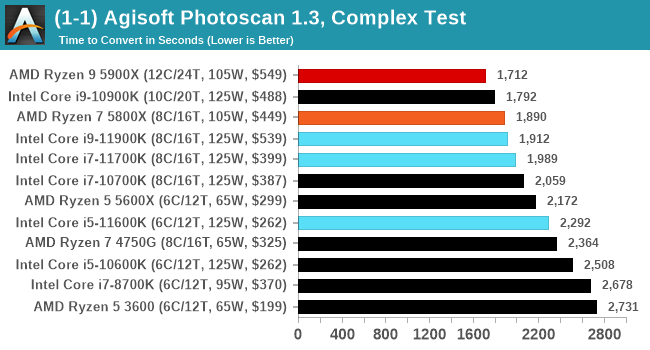
For a variable threaded load, the i9-10900K sits above the Rocket Lake parts.
RISC-V Toolchain Compile
Our latest test in our suite is the RISCV Toolchain compile from the Github source. This set of tools enables users to build software for a RISCV platform, however the tools themselves have to be built. For our test, we're running a complete fresh build of the toolchain, including from-scratch linking. This makes the test not a straightforward test of an updated compile on its own, but does form the basis of an ab initio analysis of system performance given its range of single-thread and multi-threaded workload sections. More details can be found here.
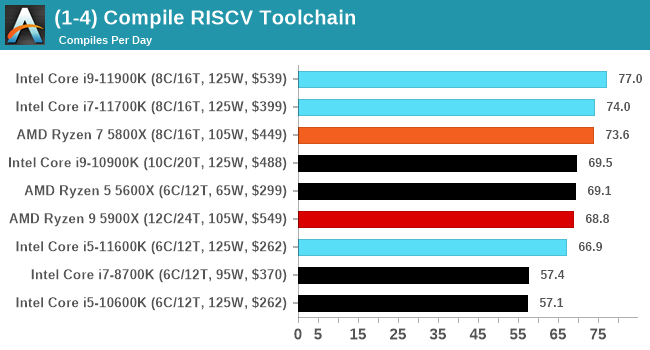
One place where Intel is winning in absolute terms in our compile-from-scratch test. We re-ran the numbers on Intel with the latest microcode due to a critical issue, but we can see here that AMD's best are single chiplet designs but Intel ekes out a small lead.
Science
In this version of our test suite, all the science focused tests that aren’t ‘simulation’ work are now in our science section. This includes Brownian Motion, calculating digits of Pi, molecular dynamics, and for the first time, we’re trialing an artificial intelligence benchmark, both inference and training, that works under Windows using python and TensorFlow. Where possible these benchmarks have been optimized with the latest in vector instructions, except for the AI test – we were told that while it uses Intel’s Math Kernel Libraries, they’re optimized more for Linux than for Windows, and so it gives an interesting result when unoptimized software is used.
3D Particle Movement v2.1: Non-AVX and AVX2/AVX512
This is the latest version of this benchmark designed to simulate semi-optimized scientific algorithms taken directly from my doctorate thesis. This involves randomly moving particles in a 3D space using a set of algorithms that define random movement. Version 2.1 improves over 2.0 by passing the main particle structs by reference rather than by value, and decreasing the amount of double->float->double recasts the compiler was adding in.
The initial version of v2.1 is a custom C++ binary of my own code, and flags are in place to allow for multiple loops of the code with a custom benchmark length. By default this version runs six times and outputs the average score to the console, which we capture with a redirection operator that writes to file.
For v2.1, we also have a fully optimized AVX2/AVX512 version, which uses intrinsics to get the best performance out of the software. This was done by a former Intel AVX-512 engineer who now works elsewhere. According to Jim Keller, there are only a couple dozen or so people who understand how to extract the best performance out of a CPU, and this guy is one of them. To keep things honest, AMD also has a copy of the code, but has not proposed any changes.
The 3DPM test is set to output millions of movements per second, rather than time to complete a fixed number of movements.
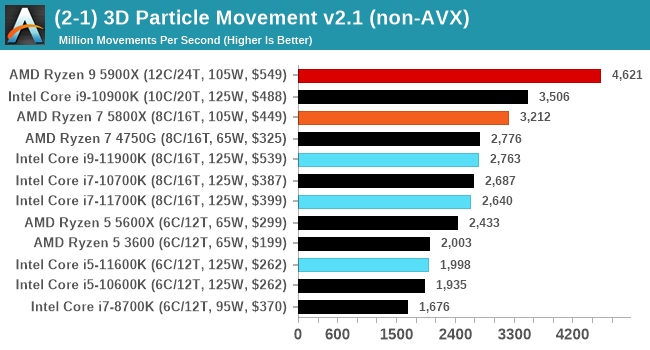
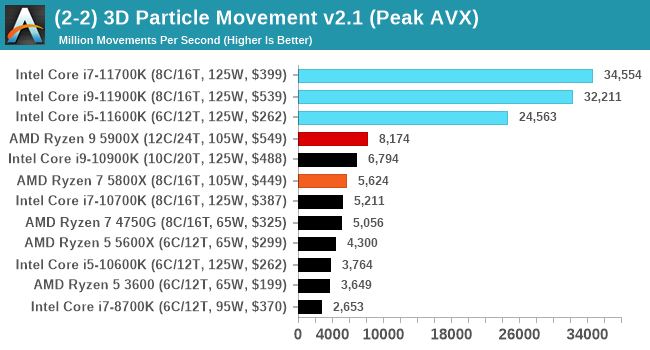
When AVX-512 comes to play, every-one else goes home. Easiest and clearest win for Intel.
y-Cruncher 0.78.9506: www.numberworld.org/y-cruncher
If you ask anyone what sort of computer holds the world record for calculating the most digits of pi, I can guarantee that a good portion of those answers might point to some colossus super computer built into a mountain by a super-villain. Fortunately nothing could be further from the truth – the computer with the record is a quad socket Ivy Bridge server with 300 TB of storage. The software that was run to get that was y-cruncher.
Built by Alex Yee over the last part of a decade and some more, y-Cruncher is the software of choice for calculating billions and trillions of digits of the most popular mathematical constants. The software has held the world record for Pi since August 2010, and has broken the record a total of 7 times since. It also holds records for e, the Golden Ratio, and others. According to Alex, the program runs around 500,000 lines of code, and he has multiple binaries each optimized for different families of processors, such as Zen, Ice Lake, Sky Lake, all the way back to Nehalem, using the latest SSE/AVX2/AVX512 instructions where they fit in, and then further optimized for how each core is built.
For our purposes, we’re calculating Pi, as it is more compute bound than memory bound. In ST and MT mode we calculate 250 million digits.
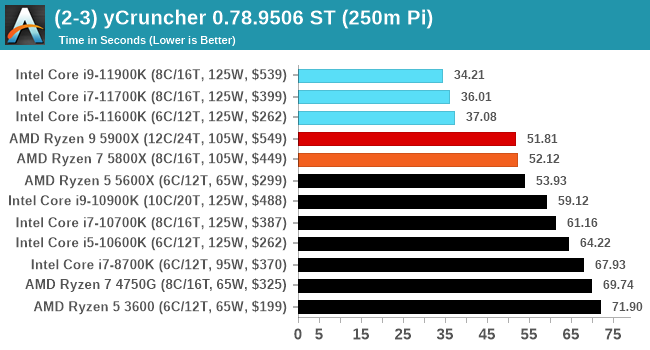

In ST mode, we are more dominated by the AVX-512 instructions, whereas in MT it becomes a mix of memory as well.
NAMD 2.13 (ApoA1): Molecular Dynamics
One of the popular science fields is modeling the dynamics of proteins. By looking at how the energy of active sites within a large protein structure over time, scientists behind the research can calculate required activation energies for potential interactions. This becomes very important in drug discovery. Molecular dynamics also plays a large role in protein folding, and in understanding what happens when proteins misfold, and what can be done to prevent it. Two of the most popular molecular dynamics packages in use today are NAMD and GROMACS.
NAMD, or Nanoscale Molecular Dynamics, has already been used in extensive Coronavirus research on the Frontier supercomputer. Typical simulations using the package are measured in how many nanoseconds per day can be calculated with the given hardware, and the ApoA1 protein (92,224 atoms) has been the standard model for molecular dynamics simulation.
Luckily the compute can home in on a typical ‘nanoseconds-per-day’ rate after only 60 seconds of simulation, however we stretch that out to 10 minutes to take a more sustained value, as by that time most turbo limits should be surpassed. The simulation itself works with 2 femtosecond timesteps. We use version 2.13 as this was the recommended version at the time of integrating this benchmark into our suite. The latest nightly builds we’re aware have started to enable support for AVX-512, however due to consistency in our benchmark suite, we are retaining with 2.13. Other software that we test with has AVX-512 acceleration.
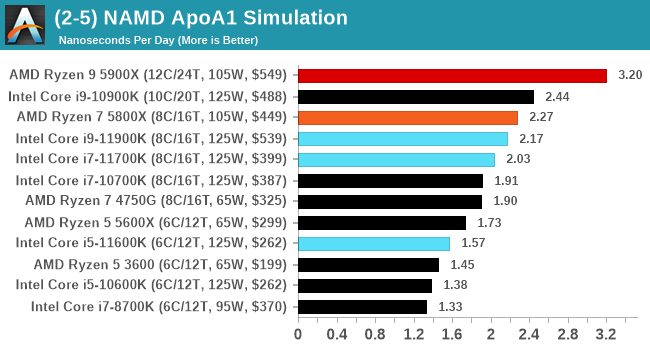
The Intel parts shows some improvement over the previous generations of Intel, however the 10-core Comet Lake still wins ahead of Rocket Lake.
AI Benchmark 0.1.2 using TensorFlow: Link
Finding an appropriate artificial intelligence benchmark for Windows has been a holy grail of mine for quite a while. The problem is that AI is such a fast moving, fast paced word that whatever I compute this quarter will no longer be relevant in the next, and one of the key metrics in this benchmarking suite is being able to keep data over a long period of time. We’ve had AI benchmarks on smartphones for a while, given that smartphones are a better target for AI workloads, but it also makes some sense that everything on PC is geared towards Linux as well.
Thankfully however, the good folks over at ETH Zurich in Switzerland have converted their smartphone AI benchmark into something that’s useable in Windows. It uses TensorFlow, and for our benchmark purposes we’ve locked our testing down to TensorFlow 2.10, AI Benchmark 0.1.2, while using Python 3.7.6.
The benchmark runs through 19 different networks including MobileNet-V2, ResNet-V2, VGG-19 Super-Res, NVIDIA-SPADE, PSPNet, DeepLab, Pixel-RNN, and GNMT-Translation. All the tests probe both the inference and the training at various input sizes and batch sizes, except the translation that only does inference. It measures the time taken to do a given amount of work, and spits out a value at the end.
There is one big caveat for all of this, however. Speaking with the folks over at ETH, they use Intel’s Math Kernel Libraries (MKL) for Windows, and they’re seeing some incredible drawbacks. I was told that MKL for Windows doesn’t play well with multiple threads, and as a result any Windows results are going to perform a lot worse than Linux results. On top of that, after a given number of threads (~16), MKL kind of gives up and performance drops of quite substantially.
So why test it at all? Firstly, because we need an AI benchmark, and a bad one is still better than not having one at all. Secondly, if MKL on Windows is the problem, then by publicizing the test, it might just put a boot somewhere for MKL to get fixed. To that end, we’ll stay with the benchmark as long as it remains feasible.
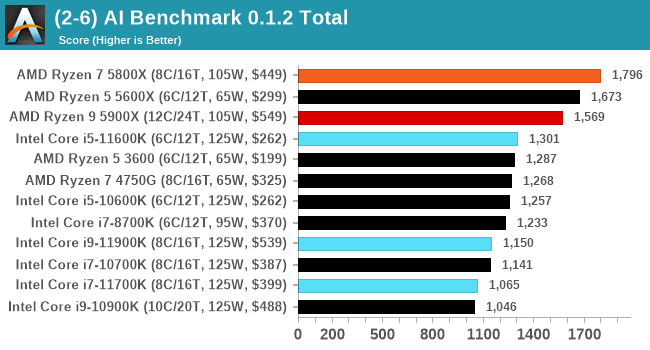
Every generation of Intel seems to regress with AI Benchmark, most likely due to MKL issues. I have previously identified the issue for Intel, however I have not heard of any progress to date.


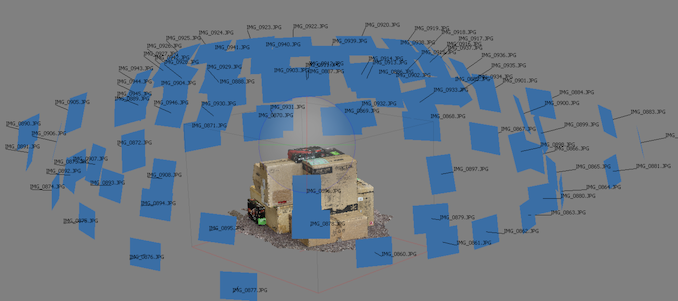
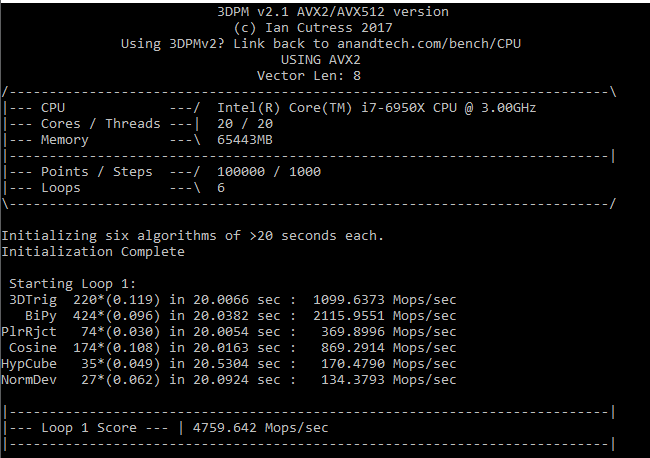
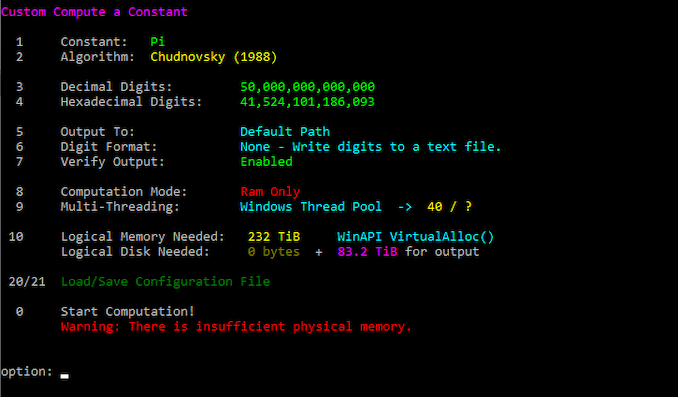










279 Comments
View All Comments
Makste - Tuesday, April 6, 2021 - link
I again have to agree with you on this. Especially with the cooler scenario, it is not easy to spot the detail, but you have managed to bring it to the surface. Rocket Lake is not a good upgrade option now that I look at it.Oxford Guy - Wednesday, March 31, 2021 - link
(Sorry I messed up and forgot quotation marks in the previous post. 1st, 3rd, and 5th paragraphs are quotes from the article.)you wrote:
‘Rocket Lake on 14nm: The Best of a Bad Situation’
I fixed it:
Rocket Lake on 14nm: Intel's Obsolete Node Produces Inferior CPU'
‘Intel is promoting that the new Cypress Cove core offers ‘up to a +19%’ instruction per clock (IPC) generational improvement over the cores used in Comet Lake, which are higher frequency variants of Skylake from 2015.’
What is the performance per watt? What is the performance per decibel? How do those compare with AMD? Performance includes performance per watt and per decibel, whether Intel likes that or not.
‘Designing a mass-production silicon layout requires balancing overall die size with expected yields, expected retail costs, required profit margins, and final product performance. Intel could easily make a 20+ core processor with these Cypress Cove cores, however the die size would be too large to be economical, and perhaps the power consumption when all the cores are loaded would necessitate a severe reduction in frequency to keep the power under control. To that end, Intel finalised its design on eight cores.’
Translation: Intel wanted to maximize margin by feeding us the ‘overclocked few cores’ design paradigm, the same thing AMD did with Radeon VII. It’s a cynical strategy when one has an inferior design. Just like Radeon VII, these run hot, loud, and underperform. AMD banked on enough people irrationally wanting to buy from ‘team red’ to sell those, while its real focus was on peddling Polaris forever™ + consoles in the GPU space. Plus, AMD sells to miners with designs like that one.
‘Intel has stated that in the future it will have cores designed for multiple process nodes at the same time, and so given Rocket Lake’s efficiency at the high frequencies, doesn’t this mean the experiment has failed? I say no, because it teaches Intel a lot in how it designs its silicon’
This is bad spin. This is not an experimental project. This is product being massed produced to be sold to consumers.
Oxford Guy - Wednesday, March 31, 2021 - link
One thing many are missing, with all the debate about AVX-512, is the AVX-2 performance per watt/decibel problem:'The rated TDP is 125 W, although we saw 160 W during a regular load, 225 W peaks with an AVX2 rendering load, and 292 W peak power with an AVX-512 compute load'
Only 225 watts? How much power does AMD's stuff use with equivalent work completion speed?
Hifihedgehog - Thursday, April 1, 2021 - link
"The spin also includes the testing, using a really loud high-CFM CPU cooler in the Intel and a different quieter one on the AMD."Keep whining... You'll eventually tire out.
https://i.imgur.com/HZVC03T.png
https://i.imgflip.com/53vqce.jpg
Makste - Tuesday, April 6, 2021 - link
Isn't it too much for you to keep posting the same thing over and over?Oxford Guy - Wednesday, March 31, 2021 - link
Overclocking support page still doesn’t mention that Intel recently discontinued the overclocking warranty, something that was available since Sandy Bridge or something. Why the continued silence on this?‘On the Overclocking Enhancement side of things, this is perhaps where it gets a bit nuanced.’
How is it an ‘enhancement’ when the chips are already system-melting hot? There isn't much that's nuanced about Intel’s sudden elimination of the overclocking warranty.
‘Overall, it’s a performance plus. It makes sense for the users that can also manage the thermals. AMD caught a wind with the feature when it moved to TSMC’s 7nm. I have a feeling that Intel will have to shift to a new manufacturing node to get the best out of ABT’
It also helps when people use extremely loud very high CFM coolers for their tests. Intel pioneered the giant hidden fridge but deafness-inducing air cooling is another option.
How much performance will buyers find in the various hearing aids they'll be in the market for? There aren't any good treatments for tinnitus, btw. That's a benefit one gets for life.
‘Intel uses one published value for sustained performance, and an unpublished ‘recommended’ value for turbo performance, the latter of which is routinely ignored by motherboard manufacturers.’
It’s also routinely ignored by Intel since it peddles its deceptive TDP.
‘This is showing the full test, and we can see that the higher performance Intel processors do get the job done quicker. However, the AMD Ryzen 7 processor is still the lowest power of them all, and finishes the quickest. By our estimates, the AMD processor is twice as efficient as the Core i9 in this test.’
Is that with the super-loud very high CFM cooler on the Intel and the smaller weaker Noctua on the AMD? If so, how about a noise comparison? Performance per decibel?
‘The cooler we’re using on this test is arguably the best air cooling on the market – a 1.8 kilogram full copper ThermalRight Ultra Extreme, paired with a 170 CFM high static pressure fan from Silverstone.’
The same publication that kneecapped AMD’s Zen 1 and Zen 2 but refusing to enable XMP for RAM on the very dubious claim that most enthusiasts don’t enter BIOS to switch it on. Most people are going to have that big loud cooler? Does Intel bundle it? Does it provide a coupon? Does the manual say you need cooler from a specific list?
BushLin - Wednesday, March 31, 2021 - link
I won't argue with the rest of your assessment but given these CPUs are essentially factory overclocked close to their limits, the only people who'd benefit from an overclocking warranty are probably a handful of benchmark freaks doing suicide runs on LN2.Oxford Guy - Thursday, April 1, 2021 - link
That’s why I said the word ‘enhancement’ seems questionable.Oxford Guy - Wednesday, March 31, 2021 - link
‘Anyone wanting a new GPU has to actively pay attention to stock levels, or drive to a local store for when a delivery arrives.’You forgot the ‘pay the scalper price at retail’ part. MSI, for instance, was the first to raise its prices across the board to Ebay scalper prices and is now threatening to raise them again.
‘In a time where we have limited GPUs available, I can very much see users going all out on the CPU/memory side of the equation, perhaps spending a bit extra on the CPU, while they wait for the graphics market to come back into play. After all, who really wants to pay $1300 for an RTX 3070 right now?’
• That is the worst possible way to deal with planned obsolescence.
14nm is already obsolete. Now, you’re adding in wating for a very long time to get a GPU, making your already obsolete CPU really obsolete by the time you can get one. If you’re waiting for reasonable prices for GPUs you’re looking at, what, more than a year of waiting?
‘Intel’s Rocket Lake as a backported processor design has worked’
No. It’s a failure. The only reasons Intel will be able to sell it is because AMD is production-constrained and because there isn’t enough competition in the x86 space to force AMD to cut the pricing of the 5000 line.
Intel also cynically hobbled the CPU by starving it of cores to increase profit for itself, banking that people will buy it anyway. It’s the desktop equivalent of Radeon VII. Small die + way too high clock to ‘compensate’ + too-high price = banking on consumer foolishness to sell them (or mining, in the case of AMD). AVX-512 isn’t really going to sell these like mining sold the Radeon VII.
‘However, with the GPU market being so terrible, users could jump an extra $100 and get 50% more AMD cores.’
No mention of power consumption, heat, and noise. Just ‘cores’ and price tag.
Oxford Guy - Wednesday, March 31, 2021 - link
'Intel could easily make a 20+ core processor with these Cypress Cove cores, however the die size would be too large to be economical'Citation needed.
And, economical for Intel or the customer?
Besides, going from 8 cores to 20+ is using hyperbole to distract from the facts.
'and perhaps the power consumption when all the cores are loaded would necessitate a severe reduction in frequency to keep the power under control.'
The few cores + excessive clocks to 'compensate' strategy is a purely cynical one. It always causes inferior performance per watt. It always causes more noise.
So, Intel is not only trying to feed us its very obsolete 14nm node, it's trying to do it in the most cynical manner it can: by trying to use 8 cores as the equivalent of what it used to peddle exclusively for the desktop market: quads.
It thinks it can keep its big margins up by segmenting this much, hoping people will be fooled into thinking the bad performance per watt from too-high clocks is just because of 14nm — not because it's cranking too few cores too high to save itself a few bucks.
Intel could offer more cores and implement as turbo with a gaming mode that would keep power under control for gaming while maximizing performance. The extra cores would presumably be able to do more work for the watts by keeping clocks/voltage more within the optimal range.
But no... it would rather give people the illusion of a gaming-optimized part ('8 cores ought to be enough for anyone') when it's only optimized for its margin.